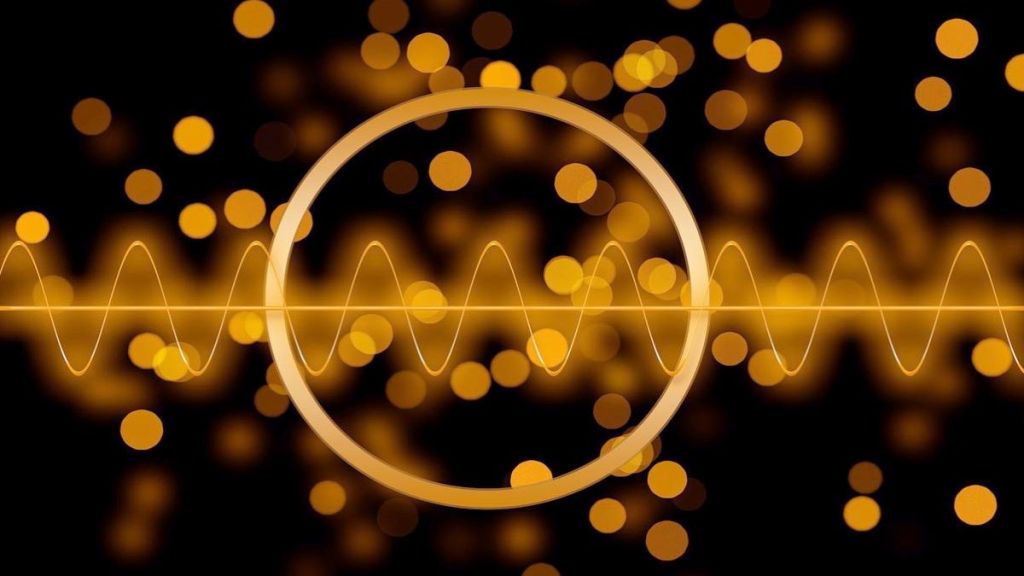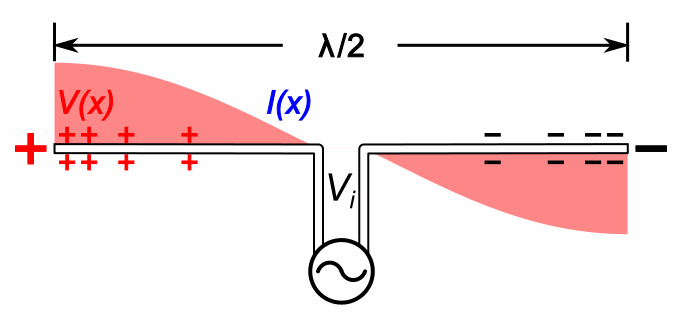
In antenna design, wavelength is represented by the Greek letter lambda. A wavelength consists of a sine wave that keeps propagating as it travels through space and atmosphere. As they propagate, the waves have to go a certain distance (lambda) before a cycle is completed. So if you have a wavelength of one meter, it literally means that the wave flows one meter before a complete cycle is reached.
A complete cycle consists of two parts — positive flowing and negative flowing. This is important to keep in mind to make sense of what follows. Lambda/4 is the ideal length for the arms or the height of many antennas. Lambda/4 is the wavelength divided by 4 or one quarter of a wavelength.
Why is lambda/4 the ideal arm length of an antenna? We’ll explore this by examining a simple dipole antenna.
The Simple Dipole Example
The dipole is a basic antenna with two arms. The signal received from the dipole is obtained from the ends of the two arms.
A properly sized dipole consists of two quarter-wavelength arms. This quite literally means that the arm is a quarter of a wavelength long. In a vacuum, if the wavelength of the signal is one meter, each arm measures one quarter of a meter in physical length.
As a simplified explanation of how the quarter-wavelength dipole arm works, the signal induced on a properly-sized receiving dipole travels down one arm, through the receiver, and out the other arm. The receiver is fed from the two ends of the arms closest to each other. The signal induced in the two arms of the dipole are flowing in the same direction, creating a current that flows through the receiver.

The RF energy the dipole is receiving is in the form of a sine wave. A full sine wave consists of a positive going half and a negative going half. Each dipole arm is a quarter wavelength, so each arm picks up half of a half cycle. Both arms together, then, pick up the entire half cycle. This means that the signal through the dipole all moves in the same direction, because the half cycle of a sine wave is either positive or negative going.
So what happens if we lengthen the dipole arms so that they are half a wavelength each?
As the RF radiation is in a sine wave, one arm picks up the positive half-cycle of the signal and the other the negative half of the signal. At the junction point of the arms, where the receiver takes the signal off of the dipole, there is no longer any signal as the two opposite going currents cancel. This is because the currents on each arm are now flowing in different directions, as one arm is seeing a half of a positive going sine wave, and the other a negative half. Of course, the cancellation is not perfect, but it is sufficient to cause problems.
So what happens if we go shorter than half a wavelength?
This is also not ideal. The result is less signal strength. We are no longer picking up as much of a half cycle of a wave as possible, hence loss of overall signal.
The final experiment we can try is to greatly increase the length of the arms of the dipole. If we make them long enough, there is no longer complete cancellation at the signal point at the junction of the arms. However, there are still bits of opposite-going signals induced on the individual arms, which will still cancel out on the arms themselves.
So, we come back to the fact that the ideal arm length for a dipole is lambda/4. Any smaller and we will not be maximizing our signal pickup. Any longer and we will began seeing interesting cancellation effects in the dipole.
The Monopole Example
A monopole antenna consists of one arm of a dipole placed over a ground plane, which serves as the other arm.
The length of each arm of a dipole (and therefore the height of a monopole) should ideally be lambda/4 or one quarter of the wavelength of the center frequency.
Hence, the “magic” number for the physical size of an antenna arm is lambda/4.
You must be logged in to post a comment.